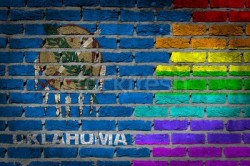If you’re considering a move to Oklahoma, you may be very afraid about what you’ll find. While the stereotypical image of Oklahoma is of horse-drawn wagons, teepees, buffalo herds, and dry, red dirt, many people are surprised by the state’s two largest cities, Oklahoma City and Tulsa. Skyscrapers dominate the downtown areas of both cities, and Oklahoma has become a surprising leader in space research and renewable energy. But one area in which the state does live up to its stereotypical image is in its very conservative, anti-LGBT stance.
 Oklahoma passed a same-sex marriage ban on November 2, 2004. The ban was in effect for almost ten years. The ban was challenged and found unconstitutional in a district court, a ruling that was upheld by the Tenth Circuit Court of Appeals. On October 6, 2014, the ban was officially overturned following the Supreme Court’s decision not to hear an appeal to the Tenth Circuit’s ruling. However, Oklahoma still has no protection for LGBT employees. The Cimarron Alliance is just one of a few LGBT groups that continue to fight for equality in the state.
Oklahoma passed a same-sex marriage ban on November 2, 2004. The ban was in effect for almost ten years. The ban was challenged and found unconstitutional in a district court, a ruling that was upheld by the Tenth Circuit Court of Appeals. On October 6, 2014, the ban was officially overturned following the Supreme Court’s decision not to hear an appeal to the Tenth Circuit’s ruling. However, Oklahoma still has no protection for LGBT employees. The Cimarron Alliance is just one of a few LGBT groups that continue to fight for equality in the state.
Despite this, there is actually a good sized gay community in the state, the majority of which live in Tulsa or Oklahoma City. Oklahoma City has a gay district, in fact, that is centered around 39thstreet. The annual Pride Parade marches through the area, and there are several gay and lesbian bars, clubs, and LGBT-owned businesses in the area. The historic Mesta Park area, which is located near downtown Oklahoma City, is another gay-friendly community. Many LGBT students attend Oklahoma City University and live in the surrounding neighborhoods, which include Mesta Park, the Gatewood District, and the Paseo District (one of the main arts districts of the city).
In Tulsa, there are two neighborhoods where LGBT people tend to gather. The first is Brady Heights, which is often called Tulsa’s gayest neighborhood. This area is near downtown and is conveniently located near a few universities, highways, and popular entertainment and shopping areas. This diverse neighborhood is fairly affordable, too.
The Florence Park area is also very LGBT-friendly. It’s also located near the downtown area, and it’s full of older homes that have a lot of charm and class to them. There are a number of small shops, bistros, and restaurants near the area plus a few major grocery stores, so Florence Park has just about everyone one would need.
The cost of living in Oklahoma is fairly low, and the state wasn’t hit as hard by the recent recession as many areas were. As a result, its economy is still fairly strong and hasn’t had to go through quite as big of a rebuilding period. The housing market is also fairly strong, and there are a number of gay and lesbian relators in the state who can help you find the perfect home.
